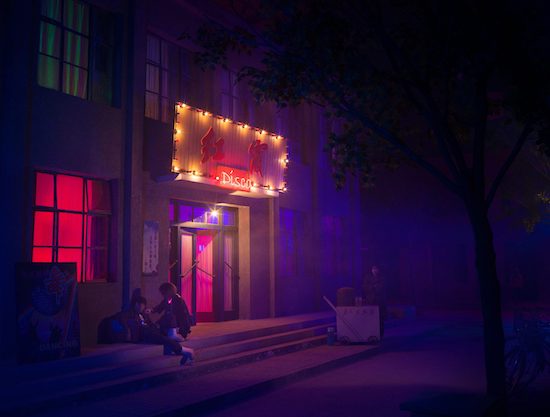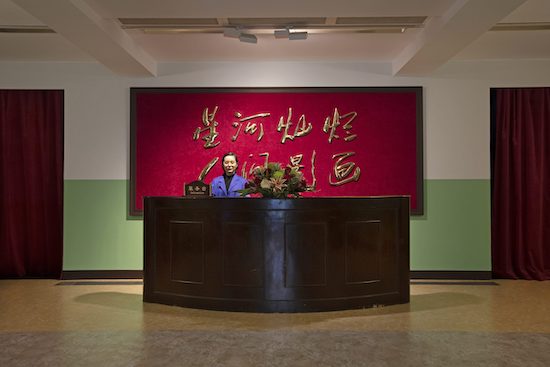Cao Fei, Blueprints (Installation view, Serpentine Gallery, 4 March – 17 May 2020) Photo credit: Gautier Deblonde
In March this year, on the cusp of the UK’s much delayed lockdown, the foyer of London’s Serpentine was transformed into Cao Fei’s Beijing cinema turned studio for her exhibition Blueprints, complete with a ticketdesk, salesperson, red curtains, and screening room. The 1970s aesthetic came coupled with a strong sense of administrative constraint. The bright staff uniform, the framed photographs trying hard to be incidental, and the plastic flowers on the salesperson’s desk all seem intended to welcome, but through their profound artifice work to intimidate more than anything else. Although audiences will undoubtedly welcome the lived experience of contemporary art once more when Blueprints reopens next week under strict Covid-19 measures, this is less a place of entertainment than one of work, development and adherence.
This stark-but-shiny alienation is compounded by yet stranger imagery. Against the backdrop of a particularly disparate session of urban tai chi, a woman stamps a letter before slipping it into a postbox, shoulders tense as if someone is watching her. Later a man lies slumped outside a disco, surrounded by a haze of neon light and the distant thump of dance music. An astronaut marches across an empty beach. Far from incongruous, these scenes from the artist’s first feature-length film, Nova, are brought together by an increasingly urgent question: where do these people belong? Despite their best efforts to find a place in the world, no one is at home in Nova. If this applies most strongly to the protagonist of the loose central narrative, a boy accidentally condemned by his scientist father to the digital realm as part of a misguided experiment, the failed ambitions of the father and the society he represents echo across the film’s many levels. His son is not the only one caught between worlds.
The fictional town of Nova is clearly made with humans in mind but is somehow unfit for their habitation. From the overbearing lights of the workers club to the cold emptiness of the streets, spaces no longer seem to accommodate the people they were designed for. Cao’s world is one of failed intentions, as if human action were now anachronistic upon its heavily developed surface.
In Cao’s Asia One, also on display, we find the same misplacing of humans repeats, this time in an enormous commercial warehouse in Beijing. To the sound of musical themes from Mao’s Great Leap Forward, workers watch with a kind of stultified fascination as machines shuffle boxes and process orders. Spectatorship is the only role left to them – one woman resorts to imitating the movements of a humanoid robot out of lack of anything else to do. The non-human takeover is happening and it isn’t terrifying, but vapid.
The tragedy that underlines Cao’s vision is that as people have tried to come to terms with the world they have only alienated themselves from it, their synthetic interventions suitable neither for nature nor themselves. In trying to alleviate their hardship through the automation of meaningless labour, they have somehow ended up cementing it further. A belief in technological solutions has made them victims of what James Bridle calls computational thought, an approach to the world that enmeshes it in systems that we wrongly interpret as mastery.
Of course, there is no mastery in the worlds we are given in Blueprints, and if the artist wants to tell us one thing it is that the world is disappearing. Both the natural world and the human world that supposedly overlays it are being overwritten by processes with their own unfathomable agency. When nature appears in Nova it is barren, empty or highly controlled – an image that Cao perhaps cultivates to avoid any misreading of her work as a call to ‘return to nature’. The few images we get of the natural world are as tainted as the hyper-industrial environments that threaten them; both are resolutely devoid of the sublime. Instead, all realms are given over to the self-perpetuating logic of growth, the endless accumulation of data and technological mediation of experience.

Cao Fei, Nova, 2019, Video, 109’. Courtesy the artist, Vitamin Creative Space and Sprüth Magers
After lockdown measures kicked in, Blueprints migrated online. It became Out of Blueprints, a virtual evolution in which artists from neighbouring regions expanded on the accelerated melancholy of the original exhibition. The mid-twentieth century utopian undertones that inflected Blueprints are now made to encompass the late capitalist maladies of the gig economy and chronic media overstimulation.
Zheng Yuan’s Dream Delivery is perhaps the most poignant contribution for its strangely touching depiction of freelance delivery men. In the film we see these men overcome their transitory, unacknowledged lives through dream; the only place they can find respite from the relentless motion of their never-ending work. “Those mobile in real life should remain still in dreams,” a voice narrates, as the exhausted delivery men lie fast asleep in a heady desert landscape, the Parthenon and the Sphinx behind them. In this world of collapsed geographies these monuments appear again, this time imposed over empty streets, a flattening of distance that reflects our experience of ordering over the internet, our items arriving almost out of nowhere. Are these future destinations for our slumbering drivers? Any possible idealisation is rendered impossible through the inclusion of real-life footage of a crash between a delivery motorcycle and an SUV later in the film, although this too is forgivingly rendered as another figment of dream.
Where Cao explores the stasis paradoxically achieved through progress, artists like Zheng use similar limbos to highlight the human cost of banality. The desire to escape or ‘improve’ the world inspires the work in both exhibitions, understood as one of modernity’s central afflictions. Both leave us with weighty questions as to exactly what image this worldly improvement takes, and whether or not it is this very ‘improvement’ itself that drives the impulse to escape.
Cao Fei, Blueprints, is at the Serpentine Gallery from 4 August to 13 September 2020


